ROM ISICHEI, TWO YEARS LATER
Recently, I visited Rom Isichei’s studio in Ilupeju. He had invited me to prepare an introduction for the catalogue of his coming exhibition “Traces of being” and I wanted to see the works at close range. Around those days I came across a copy of a lecture given by Ernst H. Gombrich in Complutense University, Madrid in January 1992. It had the title of “On the interpretation of the work of art: the what, the why and the how”. In it he tried to apply his vast wisdom and erudition to consider to what extent art historians can answer these three questions and with what degree of objectivity they can do it.
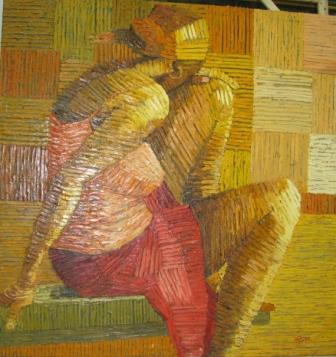 This exhibition gives an opportunity to consider the content of his current works (the “what”, the descriptive approach), the context in which he places them (the “why”, the interpretative approach) and finally, the way they are produced: his technique (the “how”, the evaluative approach). Description is the easiest. Attentiveness, sensitiveness and a little bit of experience are enough for anybody to offer a descriptive statement. Interpretation is perhaps the most difficult of the three, but the one that interests me most: the enquiry about context and meaning, the search for the relation (or lack of it) between the artwork and the cultural, economic, ethical context that surrounds it. Evaluation (the critical judgment of artistic value) I would prefer to consider it only tangentially.
This exhibition gives an opportunity to consider the content of his current works (the “what”, the descriptive approach), the context in which he places them (the “why”, the interpretative approach) and finally, the way they are produced: his technique (the “how”, the evaluative approach). Description is the easiest. Attentiveness, sensitiveness and a little bit of experience are enough for anybody to offer a descriptive statement. Interpretation is perhaps the most difficult of the three, but the one that interests me most: the enquiry about context and meaning, the search for the relation (or lack of it) between the artwork and the cultural, economic, ethical context that surrounds it. Evaluation (the critical judgment of artistic value) I would prefer to consider it only tangentially.
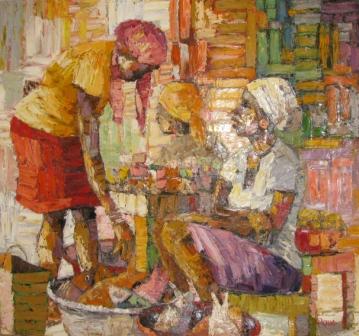 The works in the exhibition can be grouped roughly into two radically different categories: a) conventional works on canvas, b) assemblages. It is as if this were a two-man exhibition: one concerned about formal issues, the other one focused mainly on contextual ones. One set of works prominent for their “pictorial” qualities, the other one including works that primarily search to connect with values other than purely formal; works with internal references and works that try to engage in discourses external to them; artworks as aesthetic objects and artworks as cultural objects.
The works in the exhibition can be grouped roughly into two radically different categories: a) conventional works on canvas, b) assemblages. It is as if this were a two-man exhibition: one concerned about formal issues, the other one focused mainly on contextual ones. One set of works prominent for their “pictorial” qualities, the other one including works that primarily search to connect with values other than purely formal; works with internal references and works that try to engage in discourses external to them; artworks as aesthetic objects and artworks as cultural objects.
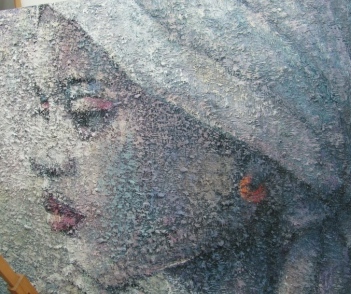 This is interesting. Rom is not just settled on his successful practice, happy to continue producing high quality aesthetic objects for the enjoyment of his patrons. I look this time at his paintings and I start thinking of what Art was for the ancients: skill. Art and skill were equivalent words. The Greeks called it techne and the Romans translated it as ars, from where we got the word in modern English. In Rom Isichei’s canvases the skill, the firm technique (techne) is obviously there. Back to Gombrich we can say that in these works, Rom is particularly successful in HOW they are executed (the rich materiality of the “impasto” strokes and the luminosity of the raw oil pigments), even if the WHAT or the WHY become nearly irrelevant. We could criticize these works as “decontextualized”, but we can’t say they are not competently done.
This is interesting. Rom is not just settled on his successful practice, happy to continue producing high quality aesthetic objects for the enjoyment of his patrons. I look this time at his paintings and I start thinking of what Art was for the ancients: skill. Art and skill were equivalent words. The Greeks called it techne and the Romans translated it as ars, from where we got the word in modern English. In Rom Isichei’s canvases the skill, the firm technique (techne) is obviously there. Back to Gombrich we can say that in these works, Rom is particularly successful in HOW they are executed (the rich materiality of the “impasto” strokes and the luminosity of the raw oil pigments), even if the WHAT or the WHY become nearly irrelevant. We could criticize these works as “decontextualized”, but we can’t say they are not competently done.
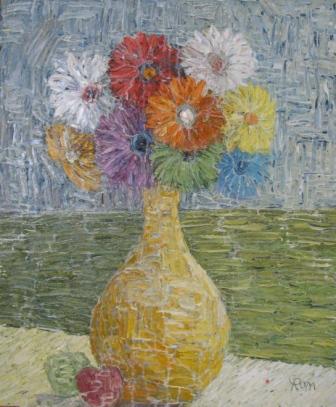 I posed this question to Rom. I asked him whether painting now a bouquet of flowers was not a kind of escapist aestheticism. His answer was clear, direct and spontaneous: “if you are a painter, what matters is nor WHAT you paint about, what really matters is HOW you paint it. How good, how innovative, how expressive, how skillful you are in painting it“. Behind these words there is a whole theory of art… Without saying so, Rom was defending an understanding of Art with a well established pedigree. Because, despite some of the excesses of the last decades there is still nowadays a strong influence of the formalism already proposed by artists and philosophers long ago (Maurice Denis wrote in 1890 “a painting is essentially a flat surface covered in colours arranged in a certain order”). That formalism was vigorously defended by Clive Bell in his book Art (1914), given new impetus by Clement Greenberg in the 1940’s and it still has supporters. Looking at Rom’s canvasses, one might be entitled to think that he is one of them.
I posed this question to Rom. I asked him whether painting now a bouquet of flowers was not a kind of escapist aestheticism. His answer was clear, direct and spontaneous: “if you are a painter, what matters is nor WHAT you paint about, what really matters is HOW you paint it. How good, how innovative, how expressive, how skillful you are in painting it“. Behind these words there is a whole theory of art… Without saying so, Rom was defending an understanding of Art with a well established pedigree. Because, despite some of the excesses of the last decades there is still nowadays a strong influence of the formalism already proposed by artists and philosophers long ago (Maurice Denis wrote in 1890 “a painting is essentially a flat surface covered in colours arranged in a certain order”). That formalism was vigorously defended by Clive Bell in his book Art (1914), given new impetus by Clement Greenberg in the 1940’s and it still has supporters. Looking at Rom’s canvasses, one might be entitled to think that he is one of them.
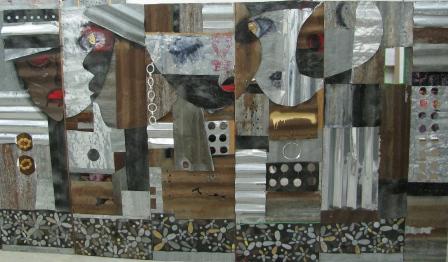 But, then, when we look at the assemblages we notice an undeniable attempt at articulating his work within a global discourse… We know that to produce a good assemblage artwork in 2009, in Nigeria, there is need for more than collecting a few discarded items, putting them together, with greater or lesser dexterity, and appending a discursive narrative on recycling and the environment. Formal qualities matter; there is also need for skill (the old Techne of the Greeks). El Anatsui is an excellent example… By now, there are a good number of imitators, collaborators, ex-students and apprentices that have learned the “trade”, but who are unable to match the rich aesthetic qualities of El’s works. If we were to give a pile of tin cans, “pure water” sachets and bottle tops to one hundred different artists and ask them to work with them, we can be sure only a few would be able to produce art works of acceptable quality. The challenge is how to sift the “wheat” from the never-ending supply of “intellectual chaff” offered to us.
But, then, when we look at the assemblages we notice an undeniable attempt at articulating his work within a global discourse… We know that to produce a good assemblage artwork in 2009, in Nigeria, there is need for more than collecting a few discarded items, putting them together, with greater or lesser dexterity, and appending a discursive narrative on recycling and the environment. Formal qualities matter; there is also need for skill (the old Techne of the Greeks). El Anatsui is an excellent example… By now, there are a good number of imitators, collaborators, ex-students and apprentices that have learned the “trade”, but who are unable to match the rich aesthetic qualities of El’s works. If we were to give a pile of tin cans, “pure water” sachets and bottle tops to one hundred different artists and ask them to work with them, we can be sure only a few would be able to produce art works of acceptable quality. The challenge is how to sift the “wheat” from the never-ending supply of “intellectual chaff” offered to us.
Rom did his first assemblage with corrugated iron sheets in 2001. Since then he has produced only nine of these pieces. In this exhibition he presents four and they are strikingly similar to his earlier ones. They cannot be approached exclusively from a formal –should I say, aesthetic- point of view. They are inserted into a narrative, into a discourse about issues, into a social and cultural context. They are “about something”. Their “aboutness” -to use Arthur Danto’s neologism- is central to the works and to our attempt at interpreting and evaluating them. Rom uses discarded materials, but it looks as if he were afraid to go “all the way”. His ubiquitous human faces are still there, even if in these works they are re-presented not by oil paint and canvas, but through metal sheets and other common materials.
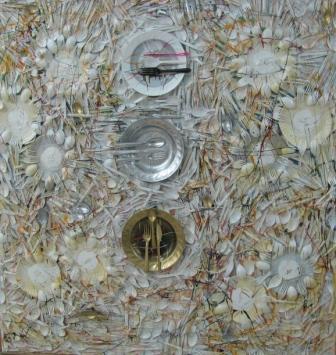 It is remarkable how consistent Rom Isichei has been since 1997 when he abandoned his professional career in advertising and decided to become a full time artist. In these years he has had five solo exhibitions. One every two years, and all of them in Lagos: 1999 “Portraits of life”, 2001 “Noble thoughts, vain shadows”, 2003 “Colours and creed”, 2005 “Eyes of the beholder”, 2007 “Chronicles”.
It is remarkable how consistent Rom Isichei has been since 1997 when he abandoned his professional career in advertising and decided to become a full time artist. In these years he has had five solo exhibitions. One every two years, and all of them in Lagos: 1999 “Portraits of life”, 2001 “Noble thoughts, vain shadows”, 2003 “Colours and creed”, 2005 “Eyes of the beholder”, 2007 “Chronicles”.
There has been consistency and continuity but there has also been evolution and development. This exhibition is another step forward, and with it, it becomes clearer that in order to evaluate his artistic production so far we should look above all at the HOW, at his excellent skill in the use of colours and pigments. Few can match him at that and we are glad that he is exhibiting again.
